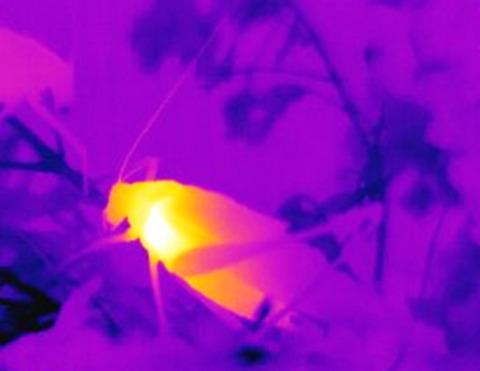当前位置:
X-MOL 学术
›
Funct. Ecol.
›
论文详情
Our official English website, www.x-mol.net, welcomes your feedback! (Note: you will need to create a separate account there.)
Insect acoustic communication: the role of transmission channel and the sensory system and brain of receivers
Functional Ecology ( IF 4.6 ) Pub Date : 2019-03-25 , DOI: 10.1111/1365-2435.13321 Heiner Römer 1
Functional Ecology ( IF 4.6 ) Pub Date : 2019-03-25 , DOI: 10.1111/1365-2435.13321 Heiner Römer 1
Affiliation

|
For decades, acoustic insects have been used as model organisms for behavioural neurobiologists to understand mate choice or predator avoidance, because behaviour can easily and reliably be elicited in the laboratory, and behaviourally relevant, identified nerve cells be studied under these conditions. However, signalling often takes place in complex environments, in which the signal perceived by the receiver may differ greatly from the one broadcast due to the biotic and abiotic properties of the sound transmission channel. Thus, the key challenge is to transfer the insights of these laboratory‐oriented experiments to more natural settings. Signal detection, identification and discrimination, as well as localization, are complicated by the transmission channel in several ways. Here, I review the empirical evidence from outdoor studies, demonstrating how excess attenuation reduces the active space and the information of a signal at some distance from the sender. At the same time, these frequency‐dependent processes allow to maintain acoustic distances to neighbours in a population. Insects often communicate within choruses of signallers of the same and different species, giving rise to high levels of acoustic masking interference. I discuss the evidence found for temporal or spatial partitioning of species in multispecies assemblages, and I show that solutions to the masking problem are based on a combination of adaptations in the behaviour of signallers and in the sensory system of receivers. Whether or not the perceived signal elicits a behaviour in receivers will depend on the design of the sensory system and the brain. I give examples for active mechanical processes in insect sensory receptors that influence the responses to external stimuli. In addition, neuronal filters in the frequency, intensity or time domain, and even the memory of individual receivers, provide the basis for adaptive receiver decision‐making in mate choice scenarios. Finally, I describe the advantages of having access to the relatively simple nervous systems of insects and how this access, combined with the use of a variety of behavioural tests, allows new insights into acoustic communication and its evolution. A free Plain Language Summary can be found within the Supporting Information of this article.
中文翻译:

昆虫声学通信:传输通道的作用以及接收器的感觉系统和大脑
几十年来,声学昆虫一直被用作行为神经生物学家的模式生物,以了解配偶选择或捕食者回避,因为在实验室中可以轻松可靠地引出行为,并且在这些条件下研究与行为相关的已识别神经细胞。然而,信号通常发生在复杂的环境中,由于声音传输通道的生物和非生物特性,接收器感知的信号可能与广播有很大不同。因此,关键的挑战是将这些面向实验室的实验的见解转移到更自然的环境中。信号检测、识别和辨别以及定位在几个方面因传输通道而变得复杂。在这里,我回顾了户外研究的经验证据,演示过度衰减如何减少活动空间和距发送器一定距离的信号信息。同时,这些频率相关的过程允许保持与人群中邻居的声学距离。昆虫经常在同一物种和不同物种的信号者的合唱团中进行交流,从而产生高水平的声学掩蔽干扰。我讨论了在多物种组合中发现的物种时间或空间划分的证据,并表明掩蔽问题的解决方案是基于信号者行为和接收者感官系统适应性的组合。感知信号是否会引发接收者的行为将取决于感觉系统和大脑的设计。我举例说明了昆虫感觉受体中影响对外部刺激反应的主动机械过程。此外,频率、强度或时域中的神经元滤波器,甚至单个接收器的记忆,为配偶选择场景中的自适应接收器决策提供了基础。最后,我描述了访问相对简单的昆虫神经系统的优势,以及这种访问如何结合各种行为测试的使用,让我们对声学通信及其进化有了新的认识。可以在本文的支持信息中找到免费的普通语言摘要。为配偶选择场景中的自适应接收器决策提供基础。最后,我描述了接触相对简单的昆虫神经系统的优势,以及这种接触如何结合各种行为测试,让我们对声学通信及其进化有了新的认识。可以在本文的支持信息中找到免费的普通语言摘要。为配偶选择场景中的自适应接收器决策提供基础。最后,我描述了接触相对简单的昆虫神经系统的优势,以及这种接触如何结合各种行为测试,让我们对声学通信及其进化有了新的认识。可以在本文的支持信息中找到免费的普通语言摘要。
更新日期:2019-03-25
中文翻译:

昆虫声学通信:传输通道的作用以及接收器的感觉系统和大脑
几十年来,声学昆虫一直被用作行为神经生物学家的模式生物,以了解配偶选择或捕食者回避,因为在实验室中可以轻松可靠地引出行为,并且在这些条件下研究与行为相关的已识别神经细胞。然而,信号通常发生在复杂的环境中,由于声音传输通道的生物和非生物特性,接收器感知的信号可能与广播有很大不同。因此,关键的挑战是将这些面向实验室的实验的见解转移到更自然的环境中。信号检测、识别和辨别以及定位在几个方面因传输通道而变得复杂。在这里,我回顾了户外研究的经验证据,演示过度衰减如何减少活动空间和距发送器一定距离的信号信息。同时,这些频率相关的过程允许保持与人群中邻居的声学距离。昆虫经常在同一物种和不同物种的信号者的合唱团中进行交流,从而产生高水平的声学掩蔽干扰。我讨论了在多物种组合中发现的物种时间或空间划分的证据,并表明掩蔽问题的解决方案是基于信号者行为和接收者感官系统适应性的组合。感知信号是否会引发接收者的行为将取决于感觉系统和大脑的设计。我举例说明了昆虫感觉受体中影响对外部刺激反应的主动机械过程。此外,频率、强度或时域中的神经元滤波器,甚至单个接收器的记忆,为配偶选择场景中的自适应接收器决策提供了基础。最后,我描述了访问相对简单的昆虫神经系统的优势,以及这种访问如何结合各种行为测试的使用,让我们对声学通信及其进化有了新的认识。可以在本文的支持信息中找到免费的普通语言摘要。为配偶选择场景中的自适应接收器决策提供基础。最后,我描述了接触相对简单的昆虫神经系统的优势,以及这种接触如何结合各种行为测试,让我们对声学通信及其进化有了新的认识。可以在本文的支持信息中找到免费的普通语言摘要。为配偶选择场景中的自适应接收器决策提供基础。最后,我描述了接触相对简单的昆虫神经系统的优势,以及这种接触如何结合各种行为测试,让我们对声学通信及其进化有了新的认识。可以在本文的支持信息中找到免费的普通语言摘要。








































 京公网安备 11010802027423号
京公网安备 11010802027423号